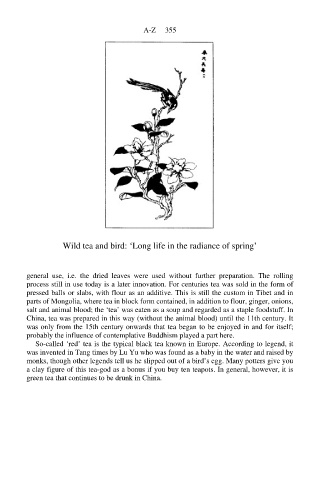Page 362 - A Dictionary of Chinese Symbols BIG Book
P. 362
A-Z 355
Wild tea and bird: ‘Long life in the radiance of spring’
general use, i.e. the dried leaves were used without further preparation. The rolling
process still in use today is a later innovation. For centuries tea was sold in the form of
pressed balls or slabs, with flour as an additive. This is still the custom in Tibet and in
parts of Mongolia, where tea in block form contained, in addition to flour, ginger, onions,
salt and animal blood; the ‘tea’ was eaten as a soup and regarded as a staple foodstuff. In
China, tea was prepared in this way (without the animal blood) until the 11th century. It
was only from the 15th century onwards that tea began to be enjoyed in and for itself;
probably the influence of contemplative Buddhism played a part here.
So-called ‘red’ tea is the typical black tea known in Europe. According to legend, it
was invented in Tang times by Lu Yu who was found as a baby in the water and raised by
monks, though other legends tell us he slipped out of a bird’s egg. Many potters give you
a clay figure of this tea-god as a bonus if you buy ten teapots. In general, however, it is
green tea that continues to be drunk in China.

